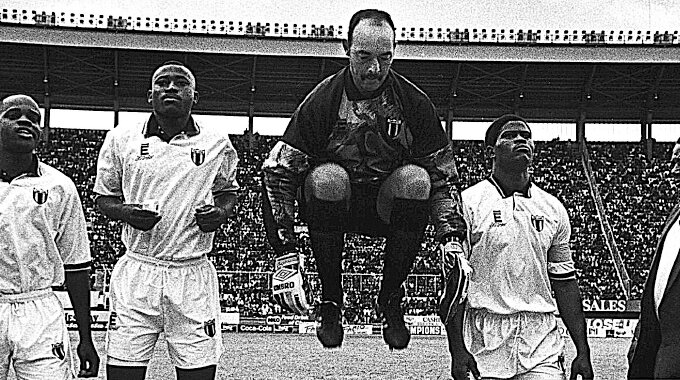Robson Sharuko Senior Sports Editor
FIFA were sitting on US$2,4 million of ZIFA’s unclaimed funds, by the end of 2018, the bulk of which could have been used by the association for development of infrastructural projects.
The funds were part of the first cycle of the Forward Development Programme.
The country’s football controlling were just one of three Southern African football countries, who did not claim even a penny of what was due to them, for investment in infrastructural projects.
ZIFA have faced chronic financial challenges in their history.
Advertisement
The Football Association of Zambia, and their Lesotho counterparts, also didn’t claim their share, related to the development of infrastructural projects, during the first cycle of the Forward Development Programme which ended on December 31, 2018.
The Zambians made the lowest claim, during that cycle, getting only US$1,5 million of their allocated US$4,425 million, which represented just 34 percent of their allocation.
FAZ did not claim a penny, for infrastructural development projects, and neither did they get a cent for equipment and travel costs.
In sharp contrast, South Africa, who have the best football infrastructure in Southern Africa — thanks to the huge investment in facilities ahead of the 2010 World Cup and the country’s thriving economy — claimed US$855 000 towards that cause during the same cycle.
Football leaders in the United States, the world’s most powerful economy, claimed US$1,406 million towards the development of infrastructural projects during that cycle and US$1,5 million towards their operational costs.
They did not claim anything towards equipment and travel. This represented 77 percent of what FIFA allocated to them.
European countries, who have some of the most developed football facilities in the world, claimed a combined average of 71 percent of their allocation from FIFA compared to just 48 percent among the 13 Southern African countries.
However, ZIFA can still claim their outstanding share of funds from FIFA, which stood at US$2,4 million at the end of the first cycle, if — before the end of this year — they can come up with proposals for the use of the funds, which the world football governing body can endorse.
FIFA have given the countries which did not exhaust their full allocation in the first cycle, including Zimbabwe, to do so by the end of this year as the world football governing body moves to implement the second cycle of the Forward Development Programme.
ZIFA, just like all the other members of FIFA, are entitled to a US$6 million injection from the Zurich-based organisation during the second phase of the cycle.
Advertisement
In the first cycle, between 2016 and 2018, ZIFA were entitled to US$4,445 million, the same amount as their sister football controlling bodies in Malawi, Mauritius, Namibia, Mozambique, Madagascar, Lesotho, Comoros, Botswana and Eswatini.
The Football Association of Zambia and the South African Football Association were allocated US$4,425 million each. The funds were to be divided into use for the development of infrastructural projects, operation costs and equipment and travel costs.
The FIFA audited financial statements for 2018, the year the first cycle of the programme ended, shows that ZIFA used only US$2,025 million, which represented only 46 percent of the US$4,445 million which was allocated to them.
The country’s football controlling body did not claim any of the funds allocated for the development of infrastructural projects related to football in this country.
ZIFA claimed US$1,5 million, for operational costs, while they also claimed a further US$525 000 for equipment and travel costs, during the same cycle.
In contrast, the Football Association of Malawi, who renovated a 10 000-seater stadium, used 81 percent of their US$4,445 million allocation from FIFA with US$1,402 million being used for the development of infrastructural projects, US$695 000 going towards equipment and travel costs and US$1,5 million going towards operational costs.
Virtually all the Southern African countries — Zimbabwe, Mauritius, Namibia, Mozambique, Seychelles, Madagascar, Zambia, Lesotho, Comoros, Botswana and Eswatini — claimed their full allocation of US$1,5 million in operational costs during the first cycle.
Only SAFA, who claimed US$1,266 million during that cycle, did not claim their full allocation.
Mauritius claimed 79 percent of their allocation, after getting US$3,506 million of their US$4,425 million, in the first cycle, the Namibians claimed 73 percent of their allocation, after receiving US$3,242 million of their US$4,425 million allocated to them.
Mozambique claimed 52 percent of their allocation, Seychelles claimed 61 percent of their allocation, Madagascar claimed 54 percent of their allocation, Lesotho claimed just 39 percent of their allocation, the Comoros claimed 46 percent of their allocation, Botswana claimed 82 percent of their allocation and Eswatini claimed 66 percent of their allocation.
Advertisement
Botswana Football Association’s claim included US$1,618 million towards he development of infrastructural projects, US1,5 million towards their operational costs and US$525 000 towards equipment and travel costs.
In total, the 13 Southern African countries claimed just 48 percent of the US$236,472 million, representing US$113,430 million, which FIFA had allocated to them in the first cycle.
However, all the countries can recoup all the money they didn’t claim if they come up with projects, endorsed by FIFA, before the end of the year.
‘‘The great news is that FIFA’s financial strength is football’s financial strength too, that revenue is going straight back into the game,’’ Alejandro Dominguez, chairman of the FIFA Finance Committee, said when the financial statements were released.
‘‘By the end of 2018, FIFA had committed Forward funds totalling US$832 million, and another US$352 million from this cycle entitlement is waiting to be released to our members.
‘‘In the new cycle, the member associations and the confederations will receive a 20 percent increase in funding for their football development under FIFA Forward 2.0.
‘‘Always with an eye on the long-term development of our sport, we have also committed US$100 million to the Football for Schools Programme, helping to take football further and wider in the world with the ultimate goal of unlocking the potential of young people on and off the pitch.
‘‘The Financial Report for 2018 offers a look inside our success. Since the launch of the programme in 2016, FIFA has released Forward funds in the amount of US$727 million to support the development not only of its member associations, but also of the six confederations and the zonal/regional associations.’’
– HERALD








